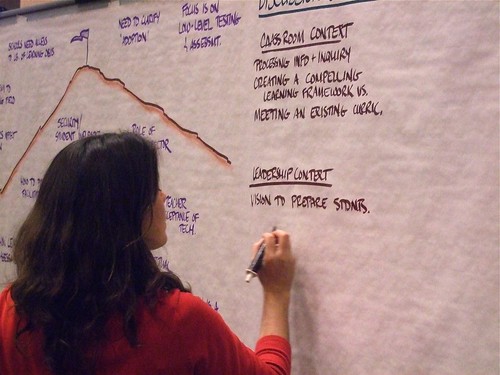
As part of their Emerging Technologies Initiative, the New Media Consortium annually publishes a document entitled the Horizon Report, which addresses new technologies and associated trends and challenges related to learning institutions. The production of this report is led by NMC staff with assistance from an advisory board. Recently, the NMC has branched into creating specialized reports such as this one addressing the implications of emerging technologies for education in Australia and New Zealand. Currently, work is underway on a K12 global edition of the Horizon Report.
Last week, I had the privilege and pleasure of attending the first advisory board meeting for this particular K12 venture in Dallas, Texas. Advisory board members hailed from around the world and work in various capacities for a variety of organizations. Some work for corporations and non-profits; others were employed by elementary, secondary, and higher education institutions. While much of the preliminary work for the K12 report is completed online through the use of a wiki, this face to face meeting facilitated a remarkable process for digging into the project. NMC documentation refers to this method as a modified Delphi process. (Incidentally, I was able to get a better grasp on the goals of the Horizon Report from this real time meeting, adding evidence to my personal belief that face to face interactions are not completely disappearing from the way we work).
In order to understand this qualitative research process, take a look at the 2009 Horizon Report recently released at ELI Annual Meeting in Orlando, Florida. This is the end result of a very defined process that is used and adapted as needed for all Horizon Reports including the current K12 one. Through the use of a wiki, advisory members were given materials to read and reflect upon. Participants were also asked to bookmark potentially relevant web sites using a common tag, and links to this del.icio.us social bookmarking feed are also posted to the wiki. All of this is done virtually, including addressing a research agenda established by NMC leaders Larry Johnson, Alan Levine and Rachel Smith. The questions on this agenda were as follows
What would you list among the established technologies that learning-focused institutions should all be using broadly today to support or enhance teaching, learning, or creative expression?
What technologies that have a solid user base in consumer, entertainment, or other industries should learning-focused institutions be actively looking for ways to apply?
What are the key emerging technologies you see developing to the point that learning-focused institutions should begin to take notice during the next 3 to 5 years? What organizations or companies are the leaders in these technologies?
What do you see as the key challenges related to teaching, learning, or creative expression that learning-focused institutions will face during the next 5 years?
What trends do you expect to have a significant impact on the ways in which learning-focused institutions approach our core missions of teaching, research, and service?
Advisory board members not present in Dallas contributed their expertise on the wiki and at our Dallas meeting, members attending added to this collection of knowledge. We vetted trends and challenges, and finally established the emerging technologies that we believe schools should adopt immediately, those that they should be looking to adopt in the two to three year range, and those that worth keeping in mind in terms of long range planning. This process was seamless and resulted a group consensus on these various topics. In general, I felt that we kept to our agenda for the day and produced tangible results by the end of meeting.
Underlying our work was the amazing graphic facilitation by NMC Vice President Rachel Smith. Rachel has a background in art education and she gave further meaning to our discussions by translating information into a graphical format. A large sheet of paper served as a whiteboard for illustrating our introductions and Rachel also transcribed trends, challenges, and technologies already logged in the wiki on to other sheets. These images really engaged us, helped refine our thinking, and will serve as an archive to which we can look back and reflect. This technique served to bridge the virtual work in the wiki (and advisory board members not present) with the face to face meeting agenda.
Graphic facilitation is a field that previously has been unknown to me and I thought it was a very powerful way of gathering information, guiding the decision making process and for reinforcing learning for participants. Rachel mentioned that these facilitators are not just used for meeting work, but also in conjunction with keynote speakers. For more information on graphic facilitation, check out the Center for Graphic Facilitation and the International Forum for Visual Practitioners website.
The work for the K12 Horizon report will continue over the next few weeks with further refinements to the short list of new and emerging technologies. NMC CEO Larry Johnson, CTO Alan Levine and Vice President Rachel Smith will also be engaged with the research and writing of the final report scheduled for release at the annual Consortium for School Networking conference March 10 -12 in Austin, Texas. Also, I will be a guest on the Seedlings podcast to talk about the work of the advisory board sometime in March. It is my hope that this practical document will serve as a catalyst for K12 educational institutions to examine their own practices related to technology and to plan for the future. Now is the time to get ahead of new technologies; we must align ourselves with changes in the way the world works and communicates.
For more information on the New Media Consortium, visit them at http://www.nmc.orge. See also information on the Horizon Project and check out their YouTube channel, their photos in Flickr, and their twitter channel!